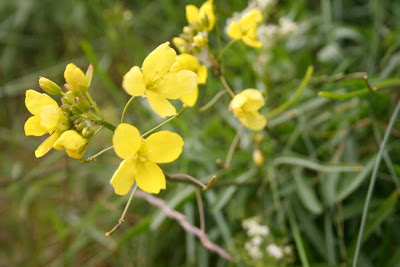
14 June 2012
green
There is a lushness to the plant life here that wasn’t present last time I came. It is enriched when the sun shines. The glaucous marram grass and sea buckthorn mingle with greener greens of bramble, elder and rose.
There are flowers: white with lime green (which I haven’t identified) and dancing heads of lemon yellow (perennial wall-rocket). Look closely and there are tiny pink flowers (again, my identification falls short and though I find something in my wild flower key that looks almost right I’m not sure) and bright yellow birds foot trefoil. Look even closer and there are caterpillars; not just the brown tailed moth larvae that are so abundant here but others with spectacular hairs. A lady bird larvae hides on a leaf, an adult crosses a blade of grass a bit further along. A beetle swims in the almost liquid sand on the steep path through the dunes to the beach; some kind of woodlouse struggles too, one I’ve never seen before.
(written on 9th June, when the sun shone between rain showers)
Subscribe to:
Post Comments (Atom)









Am sure sea buckthorn is used as a fabric dye, maybe I read about it Eco Dying, or it could have been in one of the old american dye books I have.
ReplyDeleteMight be worth giving it a try, will see if I can find the info on it. I do recall it was supposed to give a different colour than the hedgerow buckthorns.
I mayhave to go gather a little of it!
Hi Lyn. Sorry not to reply to this sooner - I meant to! I would have loved to use the plants here for dying but because it is a nature reserve that is strictly off limits. My work here must have no impact. That is why I've restricted myself to using things on the beach that remain here or I can collect because they've not originated from here.
DeleteHi Alice from Alison, writer friend of ceramicist Jan. I love your work around Spurn, it evokes the mystery of this shifting, disappearing land/seascape. I've never actually got there, but my Leonard ancestors came from Holderness and a dear uncle bird-watched there all his life. The closest I've come to it is historically: my first novel 'The Crest of the Dragon' was set in the time of Richard II, whose enemy and successor Henry Bolingbroke returned from exile to Ravenspur - the part of Spurn Head which has now disappeared under the waves -and deposed Richard to become Henry IV. All just filmed, wonderfully, from Shakespeare's plays on BBC TV. I will get there!
ReplyDeleteThanks Alison. Lovely to hear from you and your links with Spurn. Perhaps you should come over in late September when the exhibition is on...
ReplyDelete